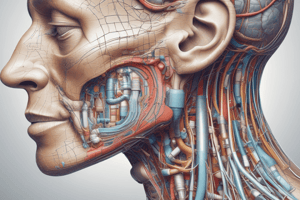Podcast
Questions and Answers
The laryngotracheal diverticulum originates from which embryonic structure?
The laryngotracheal diverticulum originates from which embryonic structure?
- Foregut (correct)
- Midgut
- Hindgut
- Pericardioperitoneal canal
The visceral pleura is formed when the lung bud breaks into the pleural cavity.
The visceral pleura is formed when the lung bud breaks into the pleural cavity.
False (B)
What is the role of surfactant in fetal lung maturation?
What is the role of surfactant in fetal lung maturation?
Surfactant reduces surface tension in the lungs, preventing the alveoli from collapsing.
The diaphragm is innervated by the phrenic nerve, which originates from spinal nerves ____, ____, and ____.
The diaphragm is innervated by the phrenic nerve, which originates from spinal nerves ____, ____, and ____.
Match the following stages of lung development with their key events:
Match the following stages of lung development with their key events:
What is a tracheoesophageal fistula?
What is a tracheoesophageal fistula?
Esophageal atresia and tracheoesophageal fistula can both result in polyhydramnios.
Esophageal atresia and tracheoesophageal fistula can both result in polyhydramnios.
What is the origin of the associated vasculature that surrounds the alveoli?
What is the origin of the associated vasculature that surrounds the alveoli?
During lung development, at what stage do the blood vessels begin to interact with the developing lung structures?
During lung development, at what stage do the blood vessels begin to interact with the developing lung structures?
Improper diaphragm development can lead to a diaphragmatic ______, in which abdominal organs compress the lungs.
Improper diaphragm development can lead to a diaphragmatic ______, in which abdominal organs compress the lungs.
Flashcards
Laryngotracheal Diverticulum
Laryngotracheal Diverticulum
Outgrowth from the foregut that develops into the larynx and trachea.
Lung Development Stages
Lung Development Stages
A series of stages including Embryonic, Pseudoglandular, Canalicular, Saccular and Alveolar.
Saccular Stage
Saccular Stage
The stage of lung development where primitive alveoli form.
Functional Lung Maturity
Functional Lung Maturity
Signup and view all the flashcards
Diaphragm Formation
Diaphragm Formation
Signup and view all the flashcards
Esophageal Atresia
Esophageal Atresia
Signup and view all the flashcards
Tracheoesophageal Fistula
Tracheoesophageal Fistula
Signup and view all the flashcards
Polyhydramnios
Polyhydramnios
Signup and view all the flashcards
Pulmonary Surfactant
Pulmonary Surfactant
Signup and view all the flashcards
Study Notes
- The laryngotracheal diverticulum is a foregut outgrowth that becomes the larynx and trachea.
- The heart being pushed down the pericardioperitoneal canal causes the formation of the laryngotracheal diverticulum.
- The respiratory diverticulum initially connects to the foregut.
- The esophagotracheal ridge forms, leading to the division into the esophagus and trachea.
- Tracheoesophageal folds appear along the lateral sides.
Lung Development Stages
- Embryonic Stage: Primary lung buds form.
- Pseudoglandular Stage: Respiratory bronchioles form and the mesoderm becomes vascularized.
- Canalicular Stage: Blood vessels grow and interact with developing lung structures.
- Saccular Stage: Primitive alveoli form.
- Alveolar Maturation Stage: Alveoli mature for gas exchange, and this continues into childhood.
- Lungs are fully mature and functional 22-26 weeks post-fertilization.
- Capillary beds surround the mature alveoli, facilitating gas exchange.
- Oxygen from the alveolus is transferred to the blood in the capillaries, while carbon dioxide is transferred from the blood to the alveolus.
Pleura Formation
- The lung bud expands into the visceral pleura without breaking into the pleural cavity.
Diaphragm Development
- The diaphragm develops from the central tendon and somites.
- The phrenic nerve (C3, C4, and C5 spinal nerves) innervates the diaphragm.
- Improper diaphragm development can lead to diaphragmatic hernia.
- Diaphragmatic hernia causes abdominal organs to compress the lungs.
Esophageal Atresia and Tracheal-Esophageal Fistula
- Esophageal atresia refers to blind pockets between the esophagus and trachea.
- Tracheal-esophageal fistula refers to an abnormal connection between the trachea and esophagus.
- Polyhydramnios is associated with both esophageal atresia and tracheal-esophageal fistula.
- Polyhydramnios is the excessive accumulation of amniotic fluid.
Lung Maturation Issues in Preterm Infants
- Surfactant is a slippery substance in the lungs that prevents tissue from sticking together.
- Surfactant keeps the lungs hydrated, and its absence can lead to lung dysfunction.
- Missing the period of surfactant production increases the risk of the fetus being non-viable
- Technology has helped improve the viability of fetuses born prematurely.
Studying That Suits You
Use AI to generate personalized quizzes and flashcards to suit your learning preferences.


